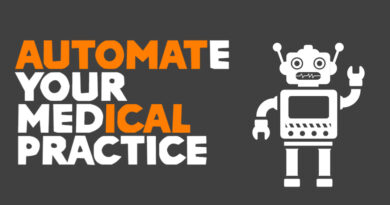Everything You Need To Know About Starting A Medical Practice
For those of you who are thinking of starting up a medical practice, I would like to help you by creating a checklist of everything you need to know to start your own medical practice.
Of course, a full list of everything you need to know about starting a medical practice is way too extensive to go through with one post. So, my goal is to have subsequent posts and put links in this post to all the follow up articles. Some of these sections will be expanded with future posts. For the sake of simplicity, I am going to assume that you are already fully licensed and have your DEA/ medical license. That is truly step one since you cannot even practice medicine without it.
If you want to open your own medical practice or are just curious to learn what it takes, well, here we go!
Step 1: Writing A Business Plan Or Pro Forma
Before you start your medical practice, consider putting your thoughts down on paper to determine a proof of concept in your area. If you are worried about how to write a business plan, do not worry. You can simply have a Pro Forma statement.
Think of a Pro Forma financial statement as a shortened less detailed business plan for your medical practice that is solely focused on financials (most of the time). Maybe a better way to think of it is a back of a napkin business plan with financial plans but on steroids and more formal appearing.
A good example of what is in a Pro Forma is a document where you have a projected balance sheet, income statement, cash flow projections and various financial options for financing.
A business plan will include all of this but more such as marketing plans, local demographics, strategy, motto, and other “fluff” that in all honesty is probably not necessary to start unless you want to put all this down on paper or is needed for financial startup for some reason.
A business plan is going to be way more in-depth. In my experience, it is only necessary if you are planning on getting investors before you even open doors.
The point of this document is to put on paper what you think realistically it can take to get the business going and keep it going. It also will serve to get you acquainted with the financial numbers of running a business.
Step 2: Register Your Medical Practice As a Legal Business
Once you have a business plan put together and possibly a name for your practice, it is time to create an LLC or PLLC if your state allows.
A PLLC is the same as an LLC but a professional LLC that is only available to doctors or lawyers.
The main benefit of a PLLC is that in many states, it protects your medical practice (you) possibly from judgments and debts during malpractice lawsuits. In other states, it really does not offer much protection. It is only one extra step, showing an active medical license to the state.
You can file your PLLC with the state by searching your secretary of state website. You can also do LegalZoom if you want something slightly more formal. I went with a lawyer to form my company to make sure that I was getting all my documentation done correctly. I used Jim Kelso.
What about S vs C corp?
This is an IRS declaration, not a state declaration. I’ll save you some time…go with the S corp. C corp is not near as common and more complicated when it comes to taxes and income.
From the IRS website:
“To qualify for S corporation status, the corporation must meet the following requirements:
- Be a domestic corporation.
- Have only allowable shareholders.
- May be individuals, certain trusts, and estates and
- May not be partnerships, corporations or non-resident alien shareholders.
- Have no more than 100 shareholders.
- Have only one class of stock.
- Not be an ineligible corporation (i.e. certain financial institutions, insurance companies, and domestic international sales corporations).”
To declare your PLLC as an S corp you will need to submit Form 2553.
Step 3: Apply for an Employer Identification Number (EIN)
Now that you have your PLLC set up and declared as a S corp, you should get a EIN.
Everyone will be asking you for this going forward to identify your medical practice (business) for tax purposes. This ranges from billing that you set up to insurance contracts so that they know how to send tax forms to and what employer identification number to attach it to.
This is very easy and free. You can follow the steps here and it can be done in only a few seconds all online.
Step 4: Open A Bank Account
You will need a business checking account in order to operate as a medical practice going forward.
Go to any bank and in order to open a business checking account you will need:
- 2 Forms of ID
- Forms with the secretary of state that you filed your PLLC or LLC (step 2)
- Forms for your EIN that you created in step 3
That is it. Now you will have a checking account that is active in your business name!
Congrats, you are officially a legal business and medical practice now!
Step 5: Secure The Finances
After reviewing what you put on paper in step 1, the next step is getting that money lined up.
Decide if you are going to take out loans or if you are going to cash flow this process by doing locums or taking call at a local hospital for example.
Figure out your road map to obtain the start up costs and multiply that estimate by 2-3 to have an operating buffer for when you open doors. Try to have 6 months of cash on hand or a plan to get cash on hand after you open your business.
For my company, I started with about $15,000 in start up costs. I also estimated about $5,000 a month in recurring costs (not including my salary). Before I opened, I figured that I would need about $40,000 to have my first six months covered.
Step 6: Find A Location
Before you can start the credentialing process, you have to have a location. I would start the process very early to figure out where you are going to open your practice.
Are going to sublease from someone or if you are going to rent a space totally on your own?
LoopNet is a commercial real estate site that has many options for commercial leases. Think of it as the Zillow for commercial real estate.
On LoopNet you can find rentals in your area and get a good idea on what you might end up paying for a commercial lease. You can also get a commercial real estate agent to help you with this process. Another option is to find local facebook groups with private practice doctors. They often will be happy to sublease you space.

Step 7: Start the Credentialing Process
Now that you have a space to possibly practice, we can start the credentialing process.
You might ask yourself, can I just credential a PO box then move it to a clinic location that I end up finding. The answer is most likely “No.” It is also a terrible idea to credential your home since many websites will index your credentialing address if approved. You really need to be able to receive mail at your credentialing address.
Credentialing takes a long time. Medicare can be as fast as 30 days, some insurance payers can be as long as 9 months. By the way, Medicare is the only one that retroactive claims. They start the clock from when you submit your application. Not from when you are approved.
You will need several things in order to start the credentialing process
- CAQH is used by pretty much all insurance companies to pull your credentialing information. Open an account or get access to yours and update your info. If you start the credentialing process without this updated, you will find that you wasted your time and will have to go back and do it all over again.
- Obtain copies of Training, licensing, certificates, previous malpractice coverage. You will need all of this going forward.
- W-9 that is filled out for your company ready and a PDF always available.
- You will need proof of active malpractice coverage and a “loss run” of previous claims (even if you have no malpractice claims in the past). You simply ask your current or previous malpractice carrier for this.
- DEA, NPI numbers.
- Work fax and phone number. DO NOT put your cell phone. You will highly regret this….I am speaking from experience 3 years later still getting faxes to my cell phone.
- Go to each insurance website, search for get credentialed in your state, and fill out the application. This is all free by the way.
- Make an excel spreadsheet of where each insurance is at in the process and keep following up once a week.
- Realize that commercial insurance will make mistakes, you will get delayed with credentialing.
- Be ready to be frustrated with credentialing if you do it yourself. For example, I opened my second office and asked to credential the 2 new providers there. One insurance company credentialed the building only, none of the providers, and took one of my current doctors out of network by accident. It took 90 days to fix the problem. During that time, that doctor could no longer see any patient with that insurance.
Step 8: Work On Setting Up Your Protocols
While your credentialing is in process, it is a good time to work on forms and processes.
Think about the last time you went to a doctors office as a patient.
You need to have the following forms or policies on hand:
- New patient paperwork
- HIPAA notice
- Release of patient information document
- Consent Forms
- New Employee Handbook
Step 9.1: Find An Electronic Medical Record Company
Choosing who you are going to use as your EMR is important but possibly not as important as you think. As you start a new company, your most likely going to be very slow in the beginning. This is the perfect time to change it if you are not happy with your electronic medical record. Although it may be a headache, it is much easier to change when you have 50 patients versus 5000 patients.
In my opinion the largest EMR’s for solo practice are as follows
There are many….many more. However, these are the most common ones that I see used in small practices for primary care or surgical practices. There are EMR’s that are more geared to derm or aesthetics that might better suit your needs.
Step 9.2: Find A Practice Management Company For Billing
A practice management company is a company / program that integrates with your EMR notes to submit bills to insurance companies or create bills for patients.
Just as its very important to find which electronic medical record you are going to go with, you need a practice management company for billing that integrates with this electronic medical record.
Essentially once you choose and EMR, you have to make sure that the practice management integrates with it.
Some companies like Kareo, Athena do both for a fee. Others like Practice Fusion only do EMR and you have to find another company to do the billing aspect.
I currently use Practice fusion which charges $100 a month but is about to go up to $150 a month per prescriber. My billing platform is Kareo. They charge $300 a month per full time prescriber. In total I pay $450 a month per prescriber for our EMR and ability to bill patients.
It might sound like a lot, but I actually think it is an amazing deal.
This includes text reminders, online scheduling, free electronic bills sent to patients with ability to pay online.
You will find that the last point is huge. Many companies will charge you $0.50 per bill you send sometimes on top of your billing fees. I recently thought about switching since a competitor to Kareo seemed to have lower pricing. However, once I had a demo I realized that they charged for all kinds of stuff like creating electronic statements to email to patients ($0.50 per statement) for example. When we send over a thousand statements a month, the $100 savings I thought I was going to have quickly turns into a $400 loss.
Look at all the fees to judge each billing (practice management) platforms carefully.
Step 10: Set Up Insurance Policies (Non malpractice)
To run a business, you will need liability insurance.
What if someone slips and falls in your waiting room and breaks a leg? Your malpractice coverage will not cover you there.
You will need a business owner policy that covers your location for potential property damage, data breaches, or bodily injury just to name a few. Hartford is a common one that many small practices use to start with by getting a quote.
Your business will also need to have workers compensation insurance as well, this is an easy add on to your business owner policy.
If you will own the property that you are practicing out of, then you will of course need a policy to cover damage to the structure of that building.
These insurance policies all together are going to be hard to find for less than $4,000 a year, so expect to spend that much no matter how small you are.
Step 11: Choose Your Accounting Software
Before you open doors, I think it is best to set up an accounting software to make your life as easy as possible. This way once the money starts coming in you can categorize it appropriately and start paying employees quickly.
I use Quickbooks and I could not be happier. In my opinion, worth every cent I spend on it.
Other business owners use Gusto for payroll. I personally tried them and did not find them to be as good as Quickbooks (my opinion). Also, it is my opinion that you will see a lot of people shilling for Gusto and not Quickbooks since Gusto gives referral bonuses and Quickbooks does not.
Quickbooks costs me all in about $450 a year to do the accounting for my practice, file all my taxes electronically and maintain compliance with all tax payments, and to pay plus track time for my employees. It is an amazing deal. I love Quickbooks.
Step 12: Create A Marketing Plan
You are getting closer and closer to opening doors. You need a website and a marketing plan. Start working on those now. Wix or Squarespace are easy websites for anyone to create a drag and drop website.
It is now time for you to decide how you are going to marked the practice.
Money is often tight in the beginning. Your view may be different but I have found the following the most cost effective for marketing:
- Advertise on Google
- Advertise on Facebook
- Go knock on doctors offices doors and get to meet the doctors. A letter is good. A doctor who brings my staff cupcakes and just wants to shake hands, exchange numbers goes 100x a generic letter. Especially one who respects my time and does not take more than 1 min of my time between patients.
- Try to get patients that first see you to leave a positive review on Google. The other review websites for doctors are as good as obsolete and at this point don’t really contribute much to your online presence.
- Have great bedside manner, provide good care, and the rest will fall into place with time
Step 13: Create Your Logo
I went on Fiverr to have my logo created. I paid someone I believe like $40 for 3 logos that I had 3 chances to give them feedback to modify it. Best $40 I ever spent. Cheap and worked out well.
Adobe Creative Cloud Express (formerly Adobe Spark) has a free logo creator too. I was shocked at how good the AI is. Hey, its free and its worth trying out!
Step 14: Set Up Accounts To Get Supplies
The two largest medical supply companies in the US are
Go to their website, set up an account, and start buying your medical supplies. Remember, that as you grow, you can argue for better prices and new “contracts” as group pricing once you hit a certain threshold.
Here you can buy everything from gloves to EKG machines to Ketamine that they will ship right to your office. You might find a better price for a used EKG machine on Ebay but you will most likely be buying 99% of your stuff through one of these two sites.
Step 15: Hire Employees
By now credentialing should be in place, you have a website, it is time to hire your first employee.
I went on Indeed to hire my first employee. Make sure you interview them face to face and get a good feel of if they are reliable. When you start out, there is nothing worse than your one and only employee not being dependable.
Check your state laws but you will need 2 forms of ID once you hire them, have them will out a W-4 and keep a I-9 on file with their two forms of ID.
Report new hires to your state workforce commission within 30 days of the hire. Be sure to give them the employee handbook so they know what expectations are.
When I started my solo practice I actually subleased not only space but the person I was subleasing from, their employees. Save money any way you can.
Step 16: Open Doors!
There will be a million other small things that come up along the way but once you made it this far, just open doors to start seeing patients!
It may sound tough but this can all be worked through by yourself….it just takes time and a lot of work.
Make a check list, don’t get bogged down. Most people get bogged down at step 1. They get stuck staring at a business plan….or lack of one.
Take the leap after doing some back of the napkin math or a Pro Forma and you fill find that the fear of the unknown is by far the worst part going from step 1 to step 2. After that, everything is much easier.
I am happy to help in any way I can and happy to answer any questions anyone may have! Feel free to reach out to me if you have any questions in the contact us or email me at investingdoc@hotmail.com
FYI: I have no paid or sponsored links in this post so I don’t have any skin in the game with trying to sway you to use one thing over another with any of the links or referrals I’ve made. 5/17/2021






How did you know there was a need in your market for your practice?
I called the local competition and chatted up the front desk. I told them I was thinking of becoming a new patient and asked what the first available is with all the doctors in the group. Even though I had a ton of competition some places were 2 months out for new patients. It was quite hard to get a new patient visit in the area.
That gave me confidence that the need is in the area and that there is room for more 🙂
About half of my competition has either retired or sold out to a concierge medical group so it also was a huge help to my group that every time one of them switched o er, I got a huge boost of new patients since some people didn’t want to pay the $1000+ yearly fee.
Pingback: The Sunday Best (5/23/2021) - Physician on FIRE
Pingback: Fawcett’s Favorites 5-31-21 – Financial Success MD
You made some good recommendations on finances, thank you.
To avoid financial issues, I also suggest minimizing initial costs. Spending all the savings in the very beginning can be risky. If you need some medical equipment, look into lightly used items that you can get for a discount. You’d be surprised how much you can save on equipment that are practically as good as new, just because someone else has owned that product before you. Or, you may also want to consider renting equipment. Cutting costs at the beginning will help you stay afloat when income is usually not very large.
Just curious, Why do you need to declare as a S corp?